Financial Accounting Report: Analysis of Clients Financial Statements
VerifiedAdded on 2021/01/22
|35
|3134
|91
Report
AI Summary
This financial accounting report provides a comprehensive analysis of various clients' financial data. It begins with an introduction to financial accounting and its importance, followed by detailed journal entries, ledger accounts, and trial balances for multiple clients. The report includes the preparation of profit and loss statements and statements of financial position. It also covers bank reconciliations, the discussion of accounting concepts like consistency and prudency, and the explanation of depreciation methods. Furthermore, the report addresses sales and purchase ledger control accounts, suspense accounts, and the differences between clearing and suspense accounts. The report also explores accounting regulations, principles, and concepts, offering a thorough understanding of financial accounting practices. This document, available on Desklib, offers a complete overview of financial accounting, aiding students in understanding and applying key financial concepts.

FINANCIAL ACCOUNTING
Paraphrase This Document
Need a fresh take? Get an instant paraphrase of this document with our AI Paraphraser
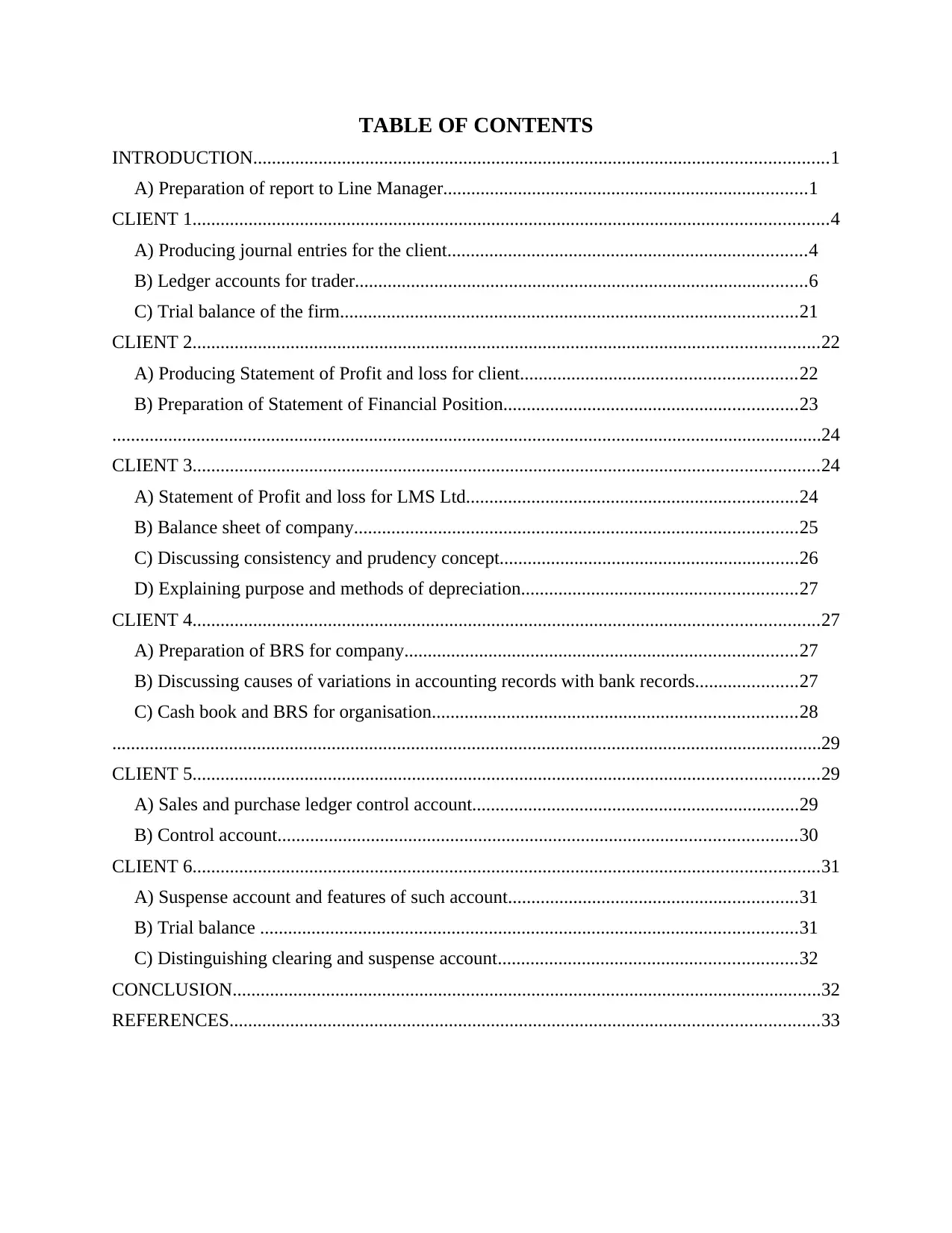
TABLE OF CONTENTS
INTRODUCTION...........................................................................................................................1
A) Preparation of report to Line Manager..............................................................................1
CLIENT 1........................................................................................................................................4
A) Producing journal entries for the client.............................................................................4
B) Ledger accounts for trader.................................................................................................6
C) Trial balance of the firm..................................................................................................21
CLIENT 2......................................................................................................................................22
A) Producing Statement of Profit and loss for client...........................................................22
B) Preparation of Statement of Financial Position...............................................................23
........................................................................................................................................................24
CLIENT 3......................................................................................................................................24
A) Statement of Profit and loss for LMS Ltd.......................................................................24
B) Balance sheet of company...............................................................................................25
C) Discussing consistency and prudency concept................................................................26
D) Explaining purpose and methods of depreciation...........................................................27
CLIENT 4......................................................................................................................................27
A) Preparation of BRS for company....................................................................................27
B) Discussing causes of variations in accounting records with bank records......................27
C) Cash book and BRS for organisation..............................................................................28
........................................................................................................................................................29
CLIENT 5......................................................................................................................................29
A) Sales and purchase ledger control account......................................................................29
B) Control account...............................................................................................................30
CLIENT 6......................................................................................................................................31
A) Suspense account and features of such account..............................................................31
B) Trial balance ...................................................................................................................31
C) Distinguishing clearing and suspense account................................................................32
CONCLUSION..............................................................................................................................32
REFERENCES..............................................................................................................................33
INTRODUCTION...........................................................................................................................1
A) Preparation of report to Line Manager..............................................................................1
CLIENT 1........................................................................................................................................4
A) Producing journal entries for the client.............................................................................4
B) Ledger accounts for trader.................................................................................................6
C) Trial balance of the firm..................................................................................................21
CLIENT 2......................................................................................................................................22
A) Producing Statement of Profit and loss for client...........................................................22
B) Preparation of Statement of Financial Position...............................................................23
........................................................................................................................................................24
CLIENT 3......................................................................................................................................24
A) Statement of Profit and loss for LMS Ltd.......................................................................24
B) Balance sheet of company...............................................................................................25
C) Discussing consistency and prudency concept................................................................26
D) Explaining purpose and methods of depreciation...........................................................27
CLIENT 4......................................................................................................................................27
A) Preparation of BRS for company....................................................................................27
B) Discussing causes of variations in accounting records with bank records......................27
C) Cash book and BRS for organisation..............................................................................28
........................................................................................................................................................29
CLIENT 5......................................................................................................................................29
A) Sales and purchase ledger control account......................................................................29
B) Control account...............................................................................................................30
CLIENT 6......................................................................................................................................31
A) Suspense account and features of such account..............................................................31
B) Trial balance ...................................................................................................................31
C) Distinguishing clearing and suspense account................................................................32
CONCLUSION..............................................................................................................................32
REFERENCES..............................................................................................................................33
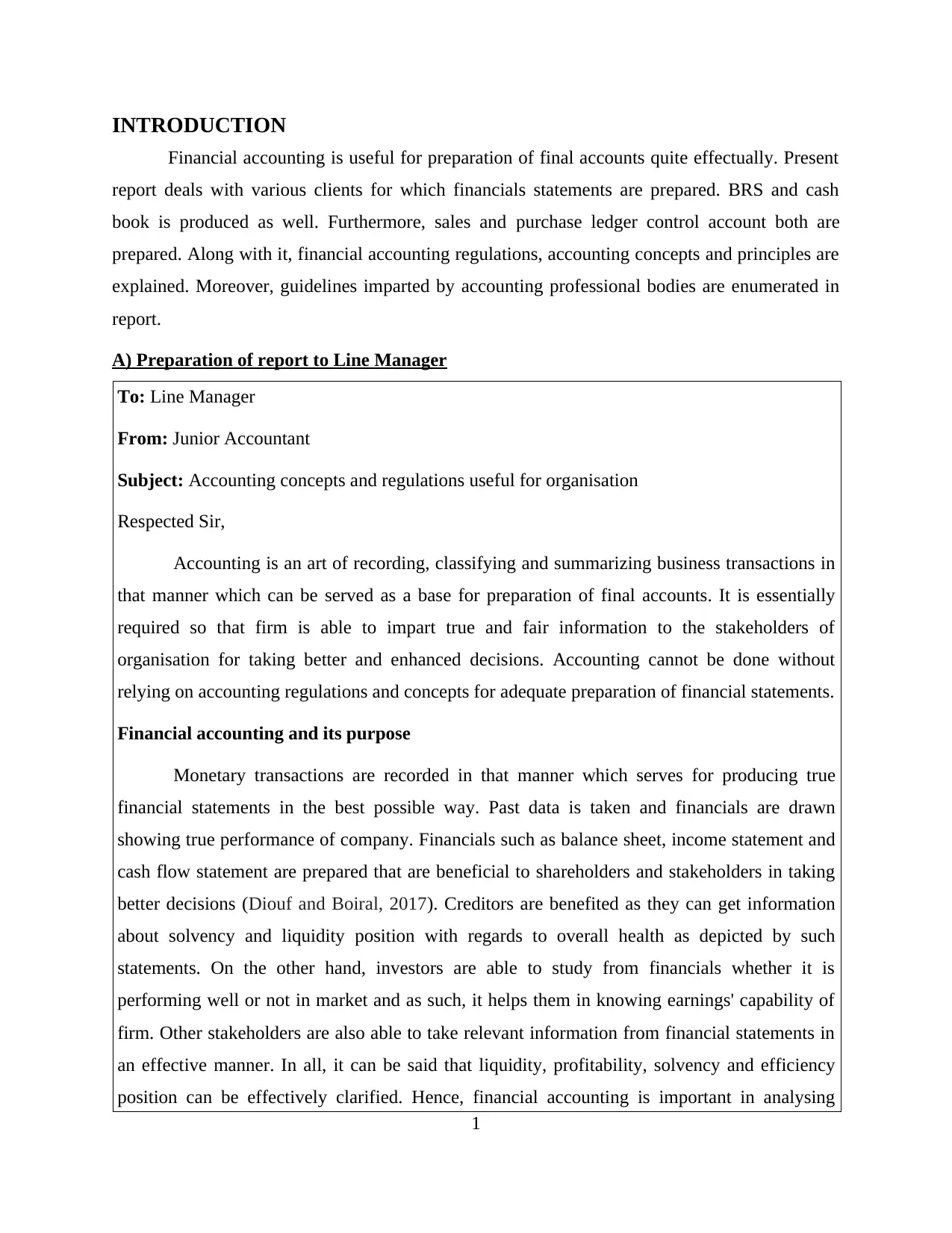
INTRODUCTION
Financial accounting is useful for preparation of final accounts quite effectually. Present
report deals with various clients for which financials statements are prepared. BRS and cash
book is produced as well. Furthermore, sales and purchase ledger control account both are
prepared. Along with it, financial accounting regulations, accounting concepts and principles are
explained. Moreover, guidelines imparted by accounting professional bodies are enumerated in
report.
A) Preparation of report to Line Manager
To: Line Manager
From: Junior Accountant
Subject: Accounting concepts and regulations useful for organisation
Respected Sir,
Accounting is an art of recording, classifying and summarizing business transactions in
that manner which can be served as a base for preparation of final accounts. It is essentially
required so that firm is able to impart true and fair information to the stakeholders of
organisation for taking better and enhanced decisions. Accounting cannot be done without
relying on accounting regulations and concepts for adequate preparation of financial statements.
Financial accounting and its purpose
Monetary transactions are recorded in that manner which serves for producing true
financial statements in the best possible way. Past data is taken and financials are drawn
showing true performance of company. Financials such as balance sheet, income statement and
cash flow statement are prepared that are beneficial to shareholders and stakeholders in taking
better decisions (Diouf and Boiral, 2017). Creditors are benefited as they can get information
about solvency and liquidity position with regards to overall health as depicted by such
statements. On the other hand, investors are able to study from financials whether it is
performing well or not in market and as such, it helps them in knowing earnings' capability of
firm. Other stakeholders are also able to take relevant information from financial statements in
an effective manner. In all, it can be said that liquidity, profitability, solvency and efficiency
position can be effectively clarified. Hence, financial accounting is important in analysing
1
Financial accounting is useful for preparation of final accounts quite effectually. Present
report deals with various clients for which financials statements are prepared. BRS and cash
book is produced as well. Furthermore, sales and purchase ledger control account both are
prepared. Along with it, financial accounting regulations, accounting concepts and principles are
explained. Moreover, guidelines imparted by accounting professional bodies are enumerated in
report.
A) Preparation of report to Line Manager
To: Line Manager
From: Junior Accountant
Subject: Accounting concepts and regulations useful for organisation
Respected Sir,
Accounting is an art of recording, classifying and summarizing business transactions in
that manner which can be served as a base for preparation of final accounts. It is essentially
required so that firm is able to impart true and fair information to the stakeholders of
organisation for taking better and enhanced decisions. Accounting cannot be done without
relying on accounting regulations and concepts for adequate preparation of financial statements.
Financial accounting and its purpose
Monetary transactions are recorded in that manner which serves for producing true
financial statements in the best possible way. Past data is taken and financials are drawn
showing true performance of company. Financials such as balance sheet, income statement and
cash flow statement are prepared that are beneficial to shareholders and stakeholders in taking
better decisions (Diouf and Boiral, 2017). Creditors are benefited as they can get information
about solvency and liquidity position with regards to overall health as depicted by such
statements. On the other hand, investors are able to study from financials whether it is
performing well or not in market and as such, it helps them in knowing earnings' capability of
firm. Other stakeholders are also able to take relevant information from financial statements in
an effective manner. In all, it can be said that liquidity, profitability, solvency and efficiency
position can be effectively clarified. Hence, financial accounting is important in analysing
1
⊘ This is a preview!⊘
Do you want full access?
Subscribe today to unlock all pages.

Trusted by 1+ million students worldwide
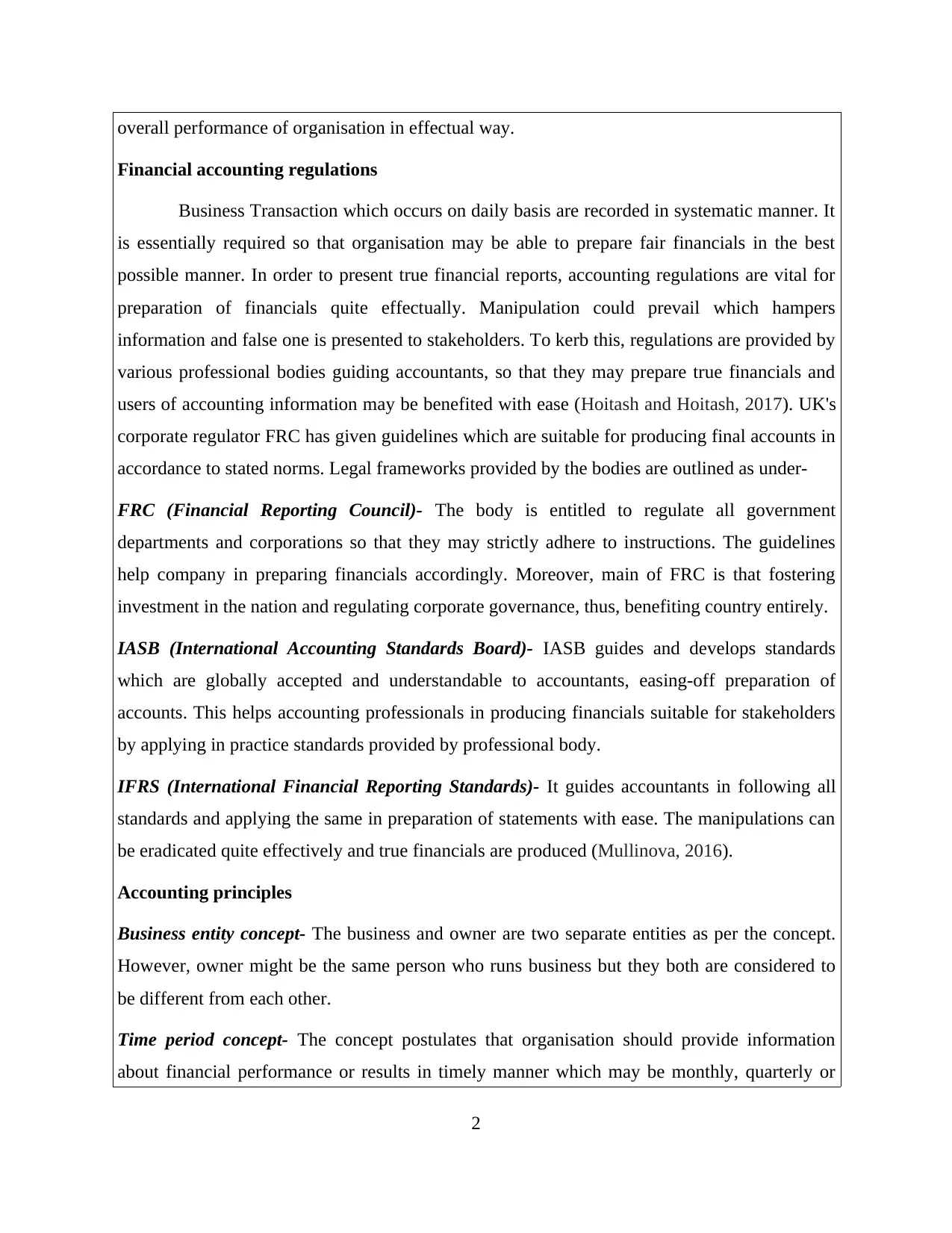
overall performance of organisation in effectual way.
Financial accounting regulations
Business Transaction which occurs on daily basis are recorded in systematic manner. It
is essentially required so that organisation may be able to prepare fair financials in the best
possible manner. In order to present true financial reports, accounting regulations are vital for
preparation of financials quite effectually. Manipulation could prevail which hampers
information and false one is presented to stakeholders. To kerb this, regulations are provided by
various professional bodies guiding accountants, so that they may prepare true financials and
users of accounting information may be benefited with ease (Hoitash and Hoitash, 2017). UK's
corporate regulator FRC has given guidelines which are suitable for producing final accounts in
accordance to stated norms. Legal frameworks provided by the bodies are outlined as under-
FRC (Financial Reporting Council)- The body is entitled to regulate all government
departments and corporations so that they may strictly adhere to instructions. The guidelines
help company in preparing financials accordingly. Moreover, main of FRC is that fostering
investment in the nation and regulating corporate governance, thus, benefiting country entirely.
IASB (International Accounting Standards Board)- IASB guides and develops standards
which are globally accepted and understandable to accountants, easing-off preparation of
accounts. This helps accounting professionals in producing financials suitable for stakeholders
by applying in practice standards provided by professional body.
IFRS (International Financial Reporting Standards)- It guides accountants in following all
standards and applying the same in preparation of statements with ease. The manipulations can
be eradicated quite effectively and true financials are produced (Mullinova, 2016).
Accounting principles
Business entity concept- The business and owner are two separate entities as per the concept.
However, owner might be the same person who runs business but they both are considered to
be different from each other.
Time period concept- The concept postulates that organisation should provide information
about financial performance or results in timely manner which may be monthly, quarterly or
2
Financial accounting regulations
Business Transaction which occurs on daily basis are recorded in systematic manner. It
is essentially required so that organisation may be able to prepare fair financials in the best
possible manner. In order to present true financial reports, accounting regulations are vital for
preparation of financials quite effectually. Manipulation could prevail which hampers
information and false one is presented to stakeholders. To kerb this, regulations are provided by
various professional bodies guiding accountants, so that they may prepare true financials and
users of accounting information may be benefited with ease (Hoitash and Hoitash, 2017). UK's
corporate regulator FRC has given guidelines which are suitable for producing final accounts in
accordance to stated norms. Legal frameworks provided by the bodies are outlined as under-
FRC (Financial Reporting Council)- The body is entitled to regulate all government
departments and corporations so that they may strictly adhere to instructions. The guidelines
help company in preparing financials accordingly. Moreover, main of FRC is that fostering
investment in the nation and regulating corporate governance, thus, benefiting country entirely.
IASB (International Accounting Standards Board)- IASB guides and develops standards
which are globally accepted and understandable to accountants, easing-off preparation of
accounts. This helps accounting professionals in producing financials suitable for stakeholders
by applying in practice standards provided by professional body.
IFRS (International Financial Reporting Standards)- It guides accountants in following all
standards and applying the same in preparation of statements with ease. The manipulations can
be eradicated quite effectively and true financials are produced (Mullinova, 2016).
Accounting principles
Business entity concept- The business and owner are two separate entities as per the concept.
However, owner might be the same person who runs business but they both are considered to
be different from each other.
Time period concept- The concept postulates that organisation should provide information
about financial performance or results in timely manner which may be monthly, quarterly or
2
Paraphrase This Document
Need a fresh take? Get an instant paraphrase of this document with our AI Paraphraser
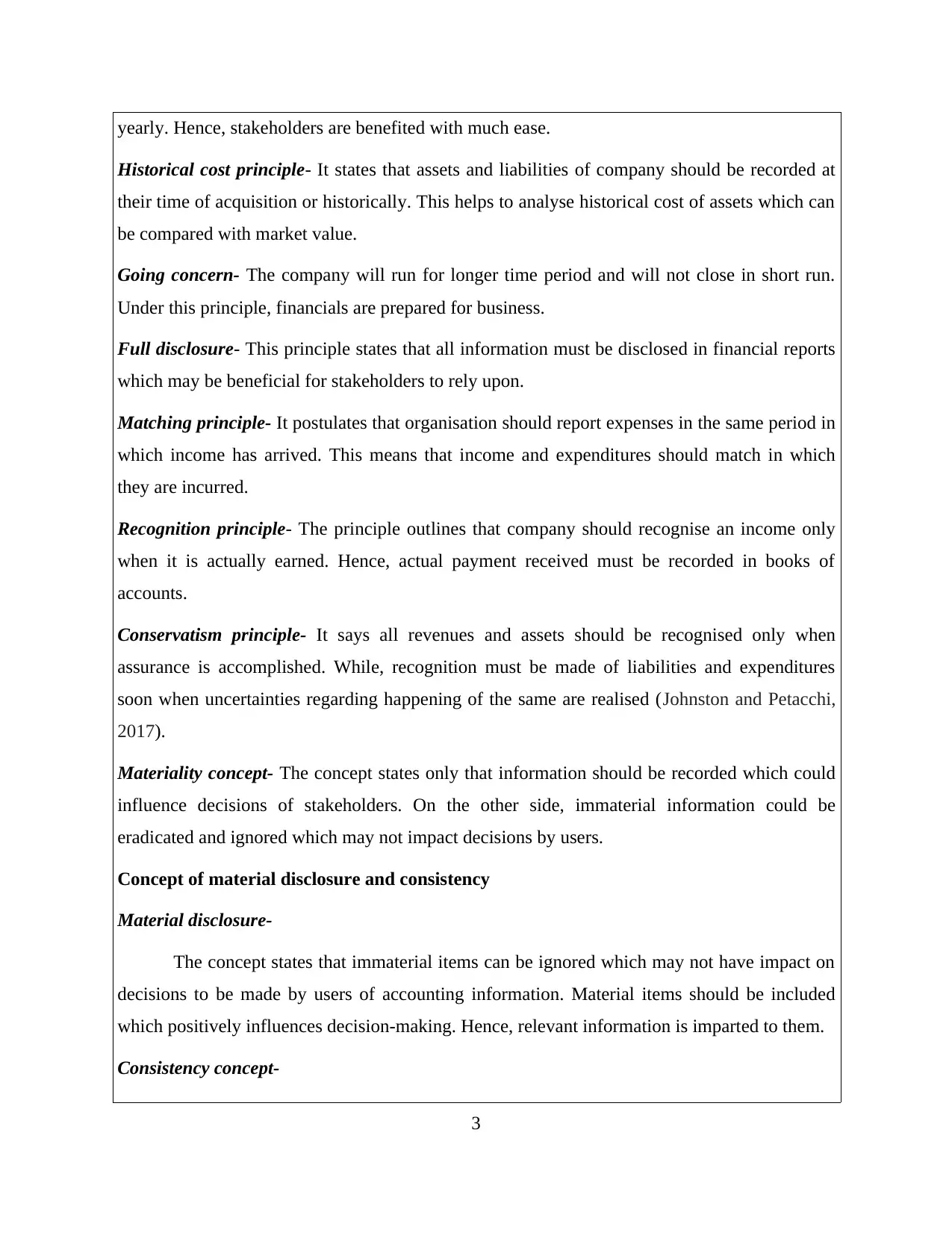
yearly. Hence, stakeholders are benefited with much ease.
Historical cost principle- It states that assets and liabilities of company should be recorded at
their time of acquisition or historically. This helps to analyse historical cost of assets which can
be compared with market value.
Going concern- The company will run for longer time period and will not close in short run.
Under this principle, financials are prepared for business.
Full disclosure- This principle states that all information must be disclosed in financial reports
which may be beneficial for stakeholders to rely upon.
Matching principle- It postulates that organisation should report expenses in the same period in
which income has arrived. This means that income and expenditures should match in which
they are incurred.
Recognition principle- The principle outlines that company should recognise an income only
when it is actually earned. Hence, actual payment received must be recorded in books of
accounts.
Conservatism principle- It says all revenues and assets should be recognised only when
assurance is accomplished. While, recognition must be made of liabilities and expenditures
soon when uncertainties regarding happening of the same are realised (Johnston and Petacchi,
2017).
Materiality concept- The concept states only that information should be recorded which could
influence decisions of stakeholders. On the other side, immaterial information could be
eradicated and ignored which may not impact decisions by users.
Concept of material disclosure and consistency
Material disclosure-
The concept states that immaterial items can be ignored which may not have impact on
decisions to be made by users of accounting information. Material items should be included
which positively influences decision-making. Hence, relevant information is imparted to them.
Consistency concept-
3
Historical cost principle- It states that assets and liabilities of company should be recorded at
their time of acquisition or historically. This helps to analyse historical cost of assets which can
be compared with market value.
Going concern- The company will run for longer time period and will not close in short run.
Under this principle, financials are prepared for business.
Full disclosure- This principle states that all information must be disclosed in financial reports
which may be beneficial for stakeholders to rely upon.
Matching principle- It postulates that organisation should report expenses in the same period in
which income has arrived. This means that income and expenditures should match in which
they are incurred.
Recognition principle- The principle outlines that company should recognise an income only
when it is actually earned. Hence, actual payment received must be recorded in books of
accounts.
Conservatism principle- It says all revenues and assets should be recognised only when
assurance is accomplished. While, recognition must be made of liabilities and expenditures
soon when uncertainties regarding happening of the same are realised (Johnston and Petacchi,
2017).
Materiality concept- The concept states only that information should be recorded which could
influence decisions of stakeholders. On the other side, immaterial information could be
eradicated and ignored which may not impact decisions by users.
Concept of material disclosure and consistency
Material disclosure-
The concept states that immaterial items can be ignored which may not have impact on
decisions to be made by users of accounting information. Material items should be included
which positively influences decision-making. Hence, relevant information is imparted to them.
Consistency concept-
3
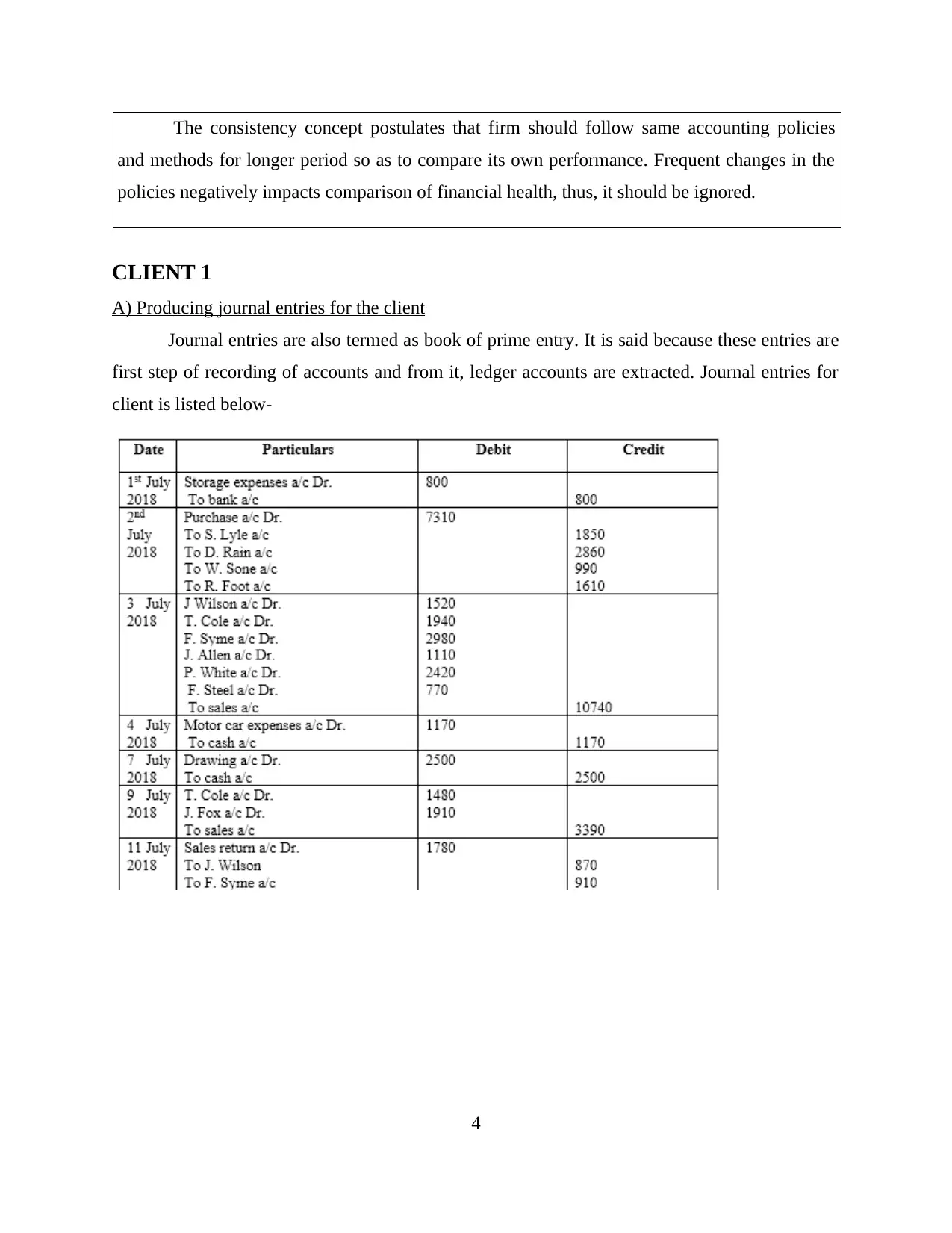
The consistency concept postulates that firm should follow same accounting policies
and methods for longer period so as to compare its own performance. Frequent changes in the
policies negatively impacts comparison of financial health, thus, it should be ignored.
CLIENT 1
A) Producing journal entries for the client
Journal entries are also termed as book of prime entry. It is said because these entries are
first step of recording of accounts and from it, ledger accounts are extracted. Journal entries for
client is listed below-
4
and methods for longer period so as to compare its own performance. Frequent changes in the
policies negatively impacts comparison of financial health, thus, it should be ignored.
CLIENT 1
A) Producing journal entries for the client
Journal entries are also termed as book of prime entry. It is said because these entries are
first step of recording of accounts and from it, ledger accounts are extracted. Journal entries for
client is listed below-
4
⊘ This is a preview!⊘
Do you want full access?
Subscribe today to unlock all pages.

Trusted by 1+ million students worldwide
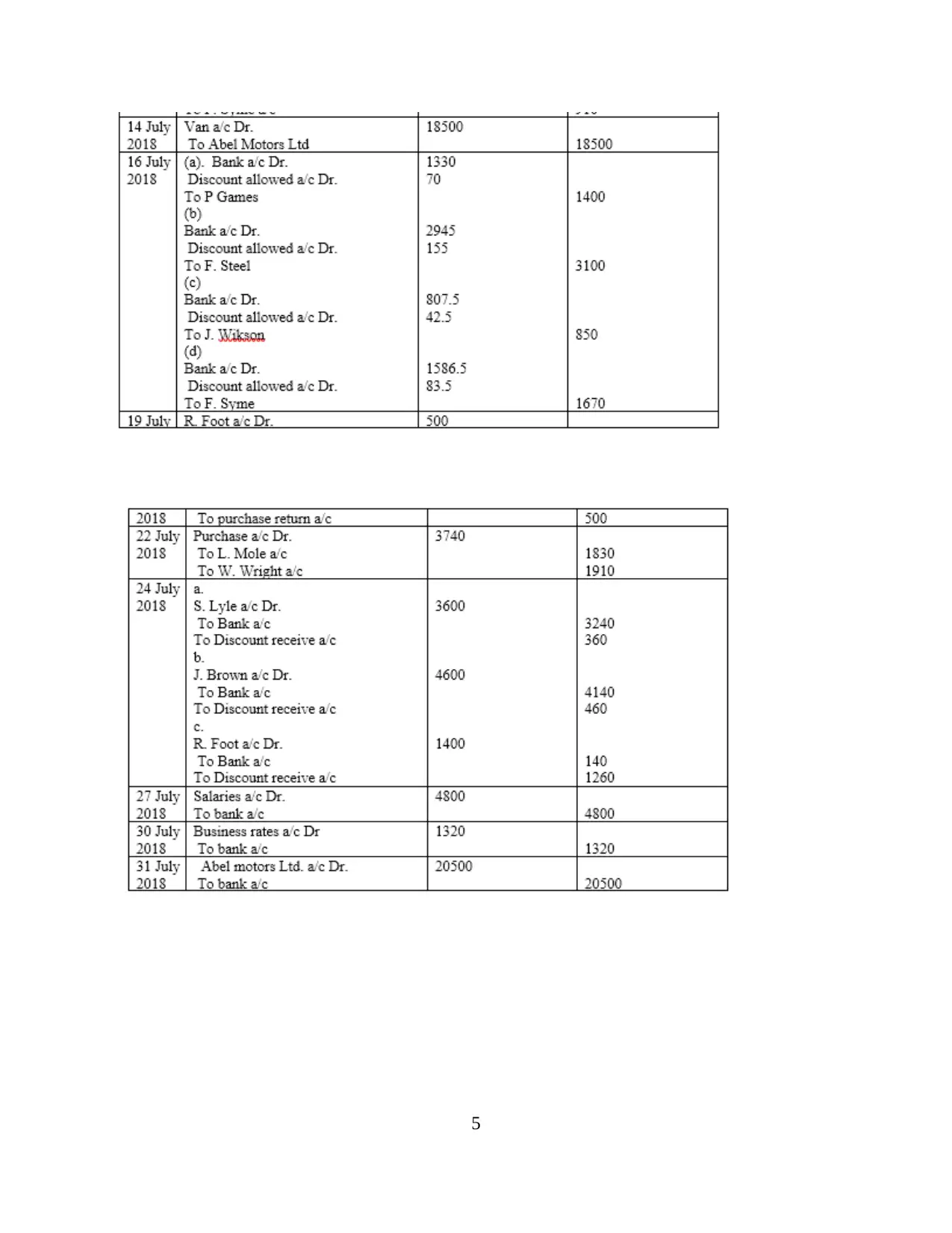
5
Paraphrase This Document
Need a fresh take? Get an instant paraphrase of this document with our AI Paraphraser
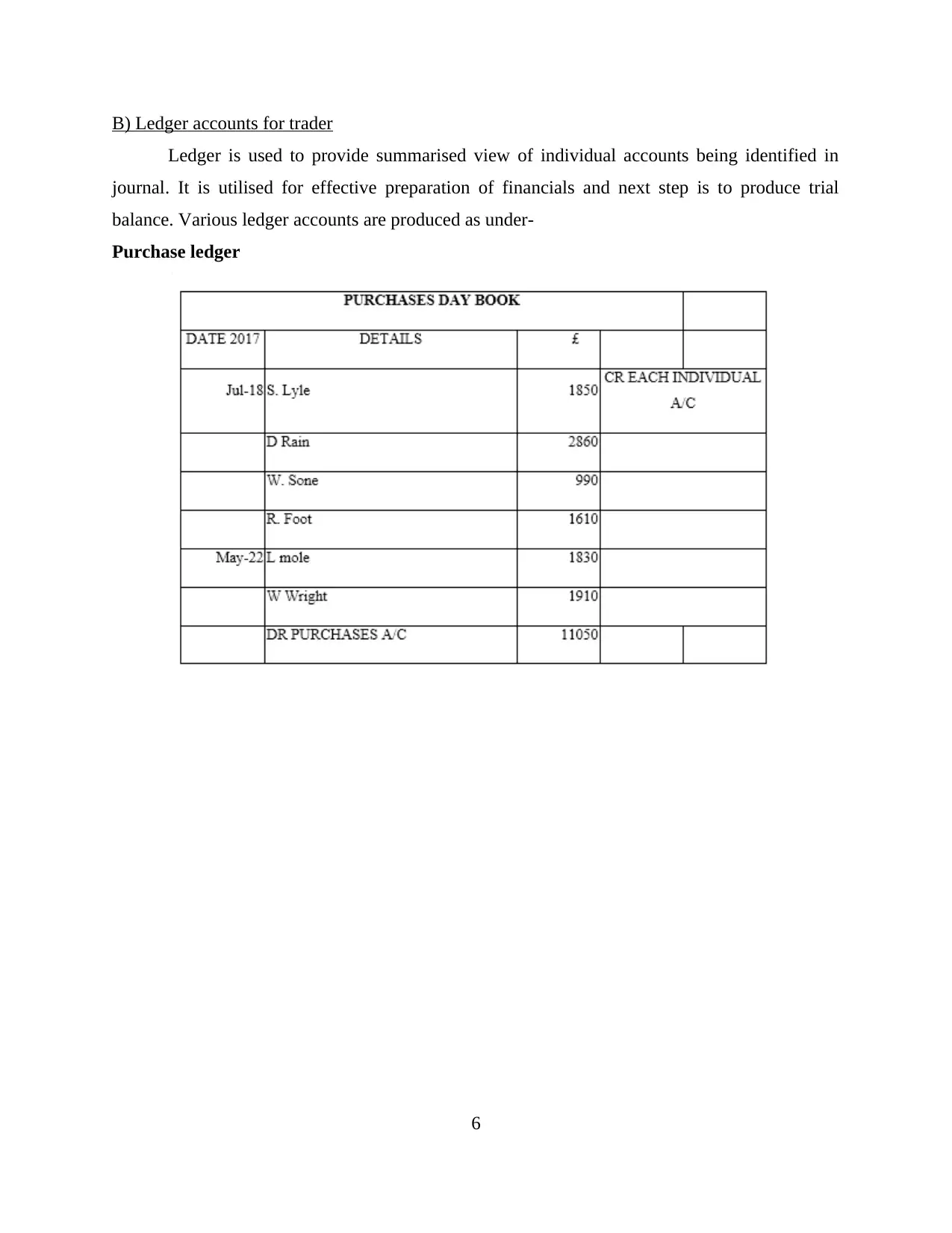
B) Ledger accounts for trader
Ledger is used to provide summarised view of individual accounts being identified in
journal. It is utilised for effective preparation of financials and next step is to produce trial
balance. Various ledger accounts are produced as under-
Purchase ledger
6
Ledger is used to provide summarised view of individual accounts being identified in
journal. It is utilised for effective preparation of financials and next step is to produce trial
balance. Various ledger accounts are produced as under-
Purchase ledger
6
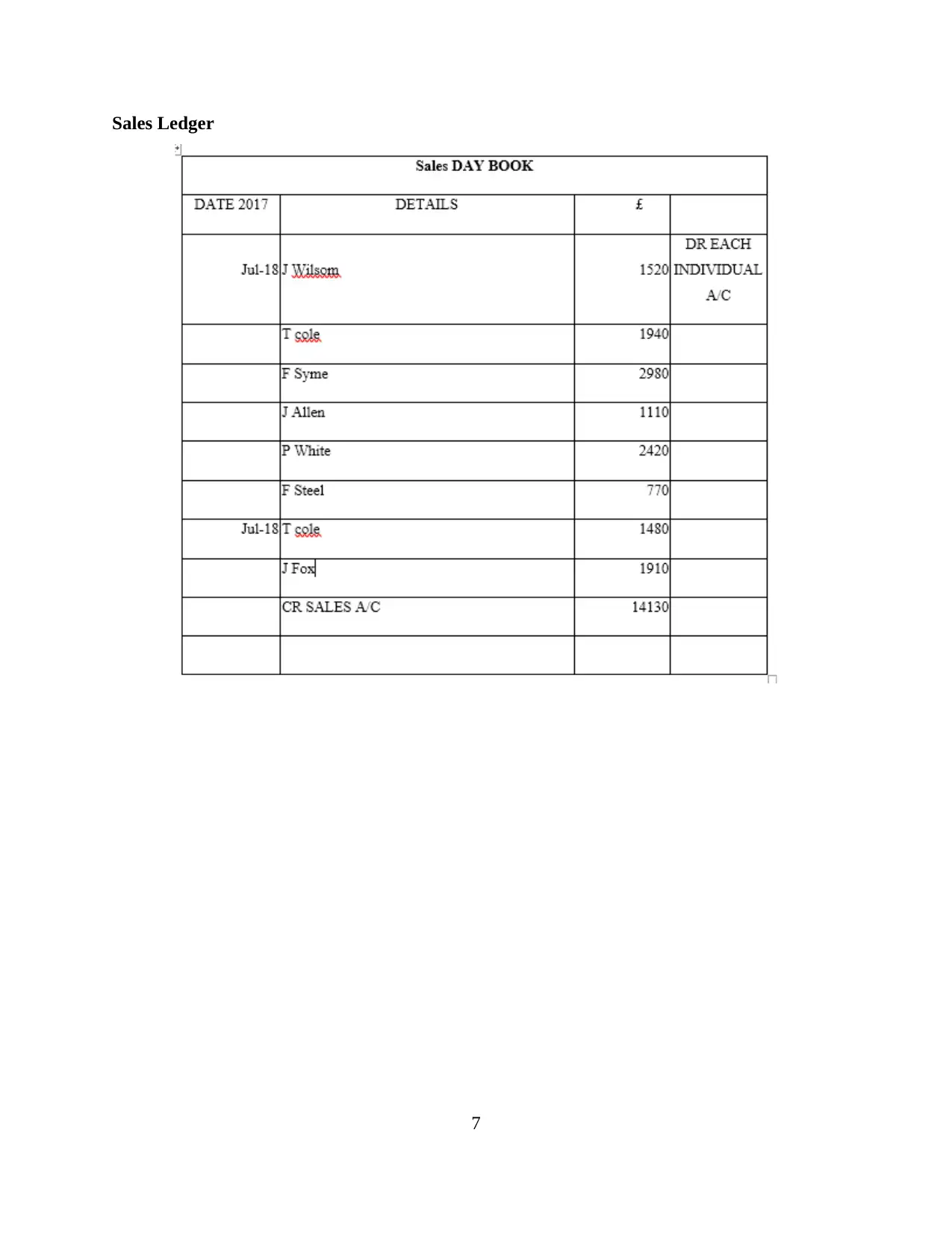
Sales Ledger
7
7
⊘ This is a preview!⊘
Do you want full access?
Subscribe today to unlock all pages.

Trusted by 1+ million students worldwide
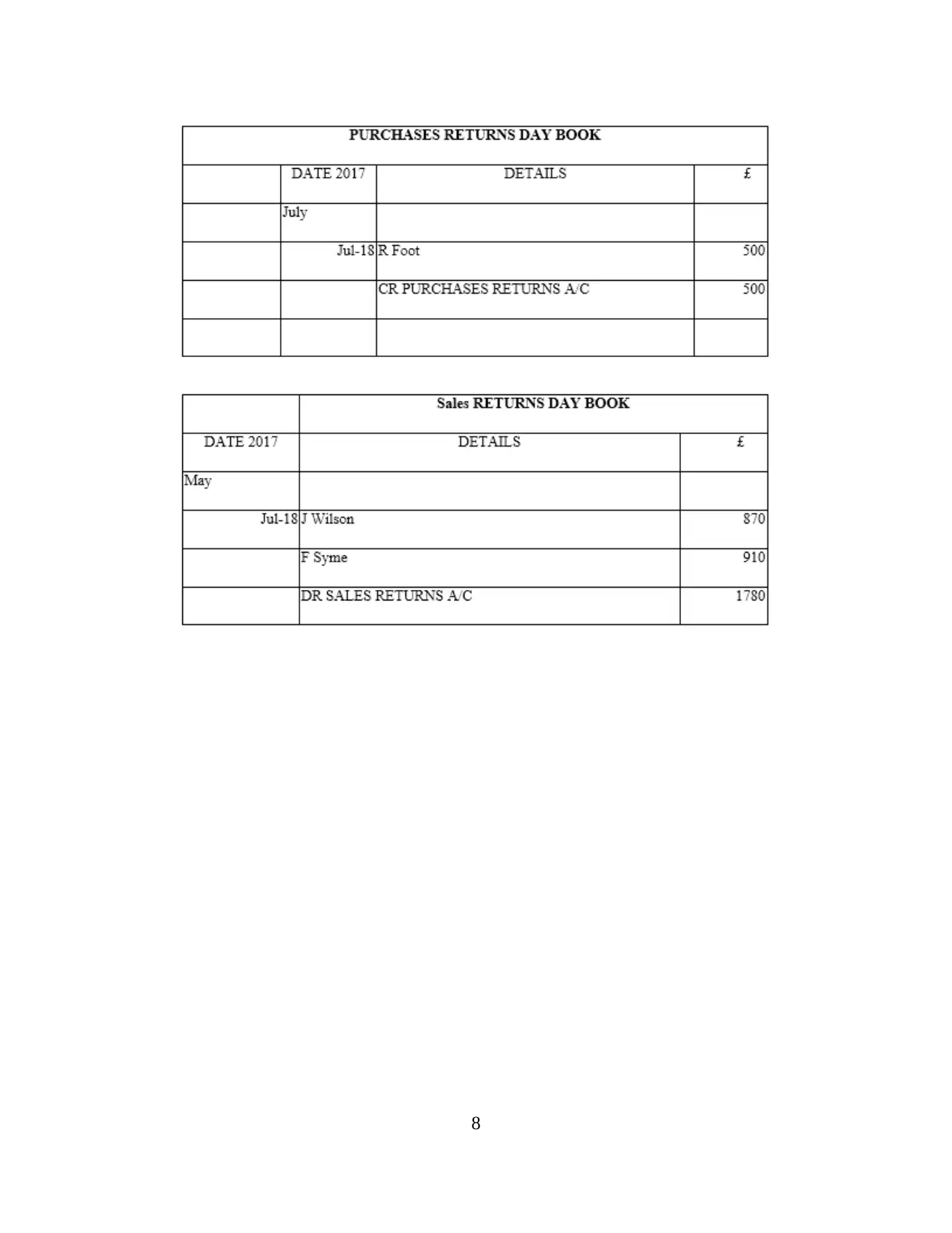
8
Paraphrase This Document
Need a fresh take? Get an instant paraphrase of this document with our AI Paraphraser
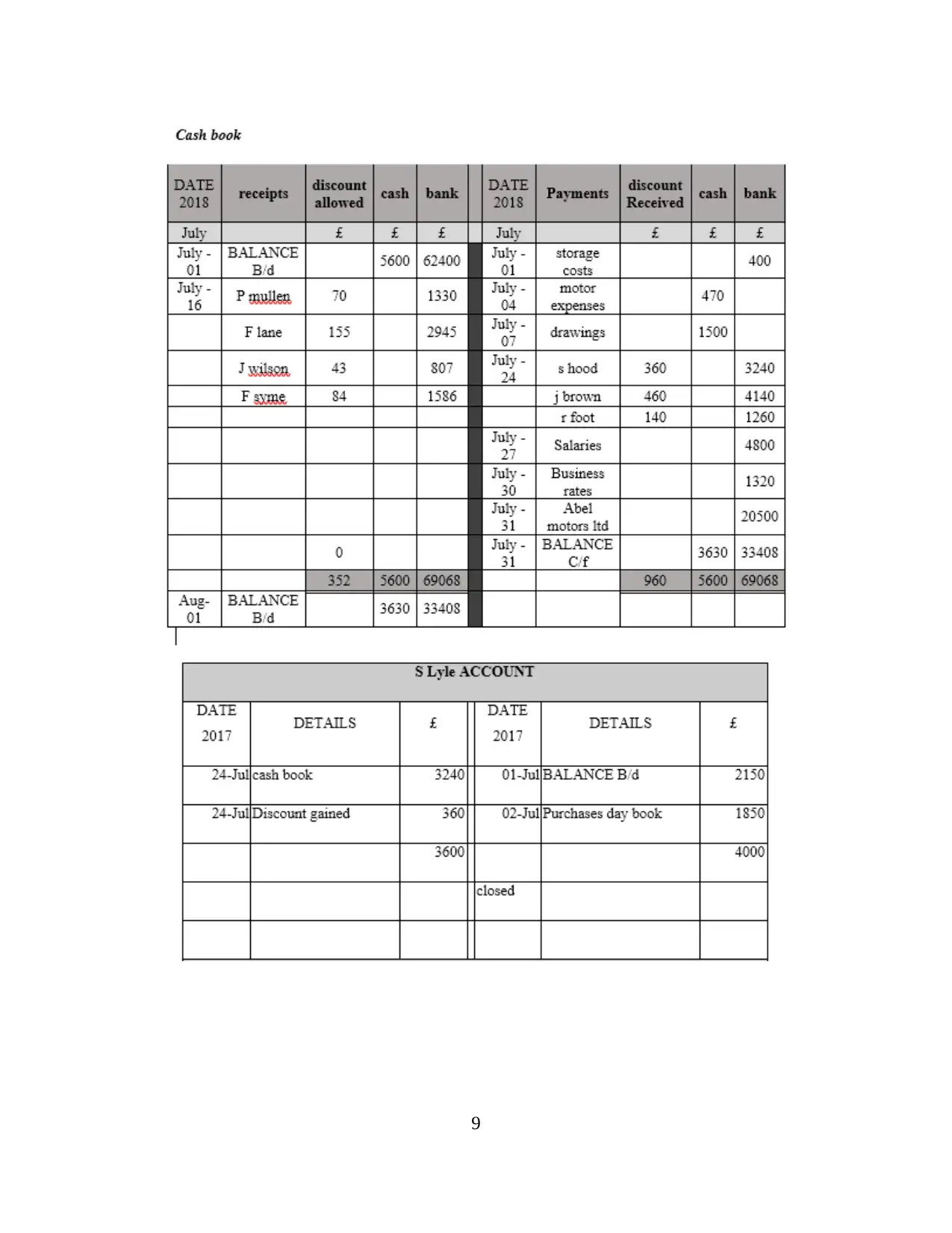
9
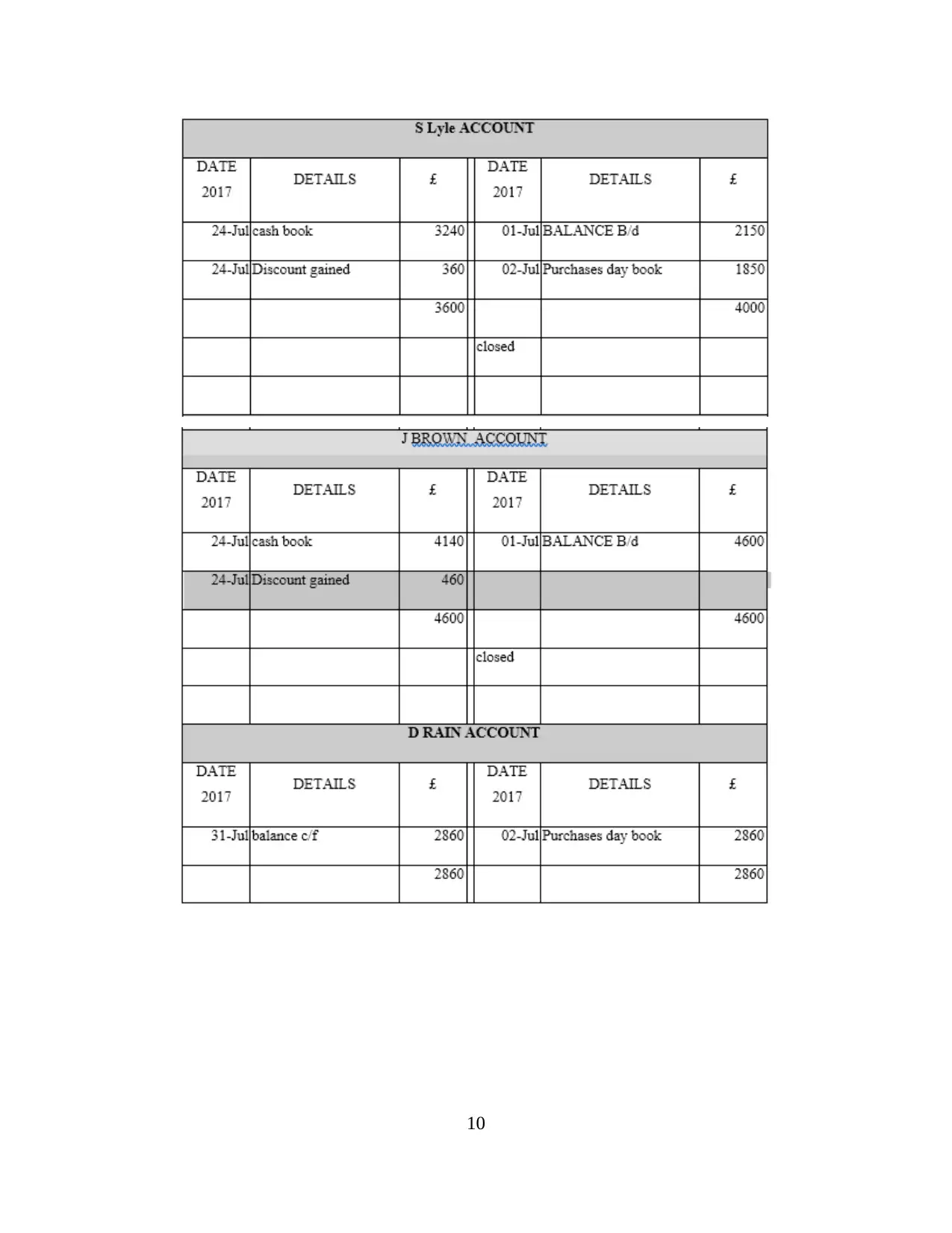
10
⊘ This is a preview!⊘
Do you want full access?
Subscribe today to unlock all pages.

Trusted by 1+ million students worldwide
1 out of 35
Related Documents
Your All-in-One AI-Powered Toolkit for Academic Success.
+13062052269
info@desklib.com
Available 24*7 on WhatsApp / Email
![[object Object]](/_next/static/media/star-bottom.7253800d.svg)
Unlock your academic potential
Copyright © 2020–2025 A2Z Services. All Rights Reserved. Developed and managed by ZUCOL.





